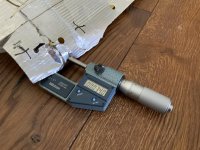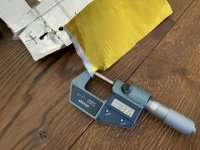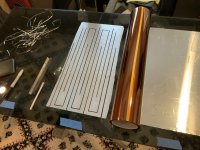
Cutting the foil is easy as long as the edges are sharp.
The triangle ceramic sharping stones keep the xacto blade sharp.
Every 3rd trace I would just resharpen an edge instead of replacing blades
continually
This Kapton roll has silicone glue on one surface BTW.
I did purchased .002” Kapton raw without glue the first time and was going to use thinned contact cement.
After experimenting with this idea , that got jettisoned quickly in favor of the pre
Silicone glued Kapton sheet. - superior in every way but other issues that make it difficult to use and handle.
More to come on this
Upper left you can see a crease again
This was my first full height Diva hand cut panel and a learning curve to go with it
This represents the Kapton glue side and the crease goes away after corrugation.
Another aspect that need addressing is lightly sanding the rough cut edges
Before accepting the Kapton sheet
Those 2 minus points get connected together and the reason is the 18” width roll compromises the connection points, but at the cheaper prices of the 18” Roll, it’s worth a separate piece of foil or wire soldered together or bolted to the MDF panel with electrical grease
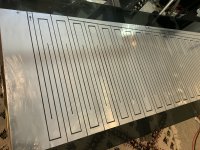
This was my first full height Diva hand cut panel and a learning curve to go with it
This represents the Kapton glue side and the crease goes away after corrugation.
Another aspect that need addressing is lightly sanding the rough cut edges
Before accepting the Kapton sheet
Those 2 minus points get connected together and the reason is the 18” width roll compromises the connection points, but at the cheaper prices of the 18” Roll, it’s worth a separate piece of foil or wire soldered together or bolted to the MDF panel with electrical grease

Last edited:
I have built these panels BUT I do not build them for sale. My experience has been decades of ribbon development in an attempt to out do the Apogee bass panel ( wich btw is the star of the show more so than the MRT)as well as develop a smaller mid and up ribbon with good reliability and lower distortion.
I learned the hard way how much has gone into Apogees development. More to it than meets the eye.
I offer a few guidelines in case u really plan on doing this....
" Whether I can find the same profile Apogee used I don't know - I don't consider that essential."
It is essential. The size/ pitch of these corrugations are an important part of producing the mechanical properties of the tensioned diaphragm. These corrugations help quiet midrange diaphragm noise, and produce a smoother and better shaped low frequency rise ( to offset baffle loss).
You can Much more easily make a flat uncorrugated diaphragm that will work surprisingly well ( U can use the silicone "dots" like Maggie uses to help with low freq resonance tuning), BUT the low freq wont be quite as smooth and the midrange resonances wont be suppressed quite as well as the corrugated design. I would say U can get about 80% of the Apogee perf with flat diaphragm.
BTW u need to use Hard Temper aluminum foil if you corrugate. over time/ hard drive, the soft temper foil will not hold the shape well and the diaphragm will wrinkle.
ALL the hype about the foam used around the panel being used as resonance control is misguided IMO.
I have experimented with about every know foam/ geometry/ design etc at the edge of these panels ( both corrugated and flat and others )and have not seen any sonic advantage as far as resonance suppression goes. IMO the foam at the edges is mostly a strain relief to avoid cracking.
"Yes, I can find rollers that large with gears and assemble a corrugator"
building a corrugator for ribbons that are only an inch or two wide is one thing, building one to corrugate a diaphragm 15 or so inches wide is a completely different animal. Standard "pinion rod" or "gear stock" on the maket can get ya close to the needed corrugation size / pitch, BUT these "rods" usually come in smaller diameters of say around 1 " or less. The problem with such small diameters trying to corrugate across 15 inches is a lot of flex in the rods that will wrinkle the foil/ plastic laminate as u go.
Larger diameters are needed and that may mean custom machined. lot of money. Also if very rigid , they have to be quite precise or may damage foil etc.
If you can cut your own and know how to do it and have a shop to do it in , then sure it can be done. BUT its not as easy as most think.
Foil/ adhesive/ backings thicknesses that have worked well in these designs
Kapton or Polyester film - from .0003" to .0005"
Adhesive - from .0003" to .0005"
foil - from .0007" to .001"
stray too far from these basic thicknesses and you start to loose perf.
Getting exactly what U want from a "roll coater" such as Lamart and others will be extremely expensive unless they just happen to have some extra from another job.
U can make a flat diaphragm out of kitchen foil ( its close to .0007" ) , 1/2 mill ( .0005") mylar.
The adhesive is the hard part, u can use 3M super 77 and a light spray coat on both surfaces. This stuff dries out in a few years but works surprisingly well. Best DIY I ve done is regular contact cement thinned out with paint thinner, then sprayed on. Very smooth thincoat and super rugged and lasts.
I learned the hard way how much has gone into Apogees development. More to it than meets the eye.
I offer a few guidelines in case u really plan on doing this....
" Whether I can find the same profile Apogee used I don't know - I don't consider that essential."
It is essential. The size/ pitch of these corrugations are an important part of producing the mechanical properties of the tensioned diaphragm. These corrugations help quiet midrange diaphragm noise, and produce a smoother and better shaped low frequency rise ( to offset baffle loss).
You can Much more easily make a flat uncorrugated diaphragm that will work surprisingly well ( U can use the silicone "dots" like Maggie uses to help with low freq resonance tuning), BUT the low freq wont be quite as smooth and the midrange resonances wont be suppressed quite as well as the corrugated design. I would say U can get about 80% of the Apogee perf with flat diaphragm.
BTW u need to use Hard Temper aluminum foil if you corrugate. over time/ hard drive, the soft temper foil will not hold the shape well and the diaphragm will wrinkle.
ALL the hype about the foam used around the panel being used as resonance control is misguided IMO.
I have experimented with about every know foam/ geometry/ design etc at the edge of these panels ( both corrugated and flat and others )and have not seen any sonic advantage as far as resonance suppression goes. IMO the foam at the edges is mostly a strain relief to avoid cracking.
"Yes, I can find rollers that large with gears and assemble a corrugator"
building a corrugator for ribbons that are only an inch or two wide is one thing, building one to corrugate a diaphragm 15 or so inches wide is a completely different animal. Standard "pinion rod" or "gear stock" on the maket can get ya close to the needed corrugation size / pitch, BUT these "rods" usually come in smaller diameters of say around 1 " or less. The problem with such small diameters trying to corrugate across 15 inches is a lot of flex in the rods that will wrinkle the foil/ plastic laminate as u go.
Larger diameters are needed and that may mean custom machined. lot of money. Also if very rigid , they have to be quite precise or may damage foil etc.
If you can cut your own and know how to do it and have a shop to do it in , then sure it can be done. BUT its not as easy as most think.
Foil/ adhesive/ backings thicknesses that have worked well in these designs
Kapton or Polyester film - from .0003" to .0005"
Adhesive - from .0003" to .0005"
foil - from .0007" to .001"
stray too far from these basic thicknesses and you start to loose perf.
Getting exactly what U want from a "roll coater" such as Lamart and others will be extremely expensive unless they just happen to have some extra from another job.
U can make a flat diaphragm out of kitchen foil ( its close to .0007" ) , 1/2 mill ( .0005") mylar.
The adhesive is the hard part, u can use 3M super 77 and a light spray coat on both surfaces. This stuff dries out in a few years but works surprisingly well. Best DIY I ve done is regular contact cement thinned out with paint thinner, then sprayed on. Very smooth thincoat and super rugged and lasts.
Last edited:
I have already made a corrugation tool that accepts the width for this panel and I had to put rubber wheels in its center area to keep it down.
You dont need gears at all as it feeds itself without difficulty and I have a hand drum for leverage to turn and feed the foil.
As far as the foam Issue is concerned I believe it can be improved upon to get more longevity. They were compressing the foam down almost flat and under those conditions
The air and smog already does a number on all foams regardless of mfgr.
I will use the denser closed cell stuff and give it half compression and hope for longer life
The foam longevity from various mfgrs is relatively short when you look at their specs.
Under room temps and used within reason you should get double life out of it
Apogee on new speakers had the buzz if driven fairly hard so to say they had this area ironed out is a bit ridiculous. Still room for improvement or at least longer life.
I will post the jig and results in due time as I am doing this in steps for the audience
Regards
David
You dont need gears at all as it feeds itself without difficulty and I have a hand drum for leverage to turn and feed the foil.
As far as the foam Issue is concerned I believe it can be improved upon to get more longevity. They were compressing the foam down almost flat and under those conditions
The air and smog already does a number on all foams regardless of mfgr.
I will use the denser closed cell stuff and give it half compression and hope for longer life
The foam longevity from various mfgrs is relatively short when you look at their specs.
Under room temps and used within reason you should get double life out of it
Apogee on new speakers had the buzz if driven fairly hard so to say they had this area ironed out is a bit ridiculous. Still room for improvement or at least longer life.
I will post the jig and results in due time as I am doing this in steps for the audience
Regards
David
I hear ya AVWERK
yes The small diameter pinion rods with some "helper rolls" at center. Good idea
yes The small diameter pinion rods with some "helper rolls" at center. Good idea
As far as glues go their is no comparison to the adhesive backed premade Kapton foils.
You cant beat the evenness with any spray adhesives. Spray 90 is superior to 77 at any level if you go this way
I will post the process of how to use this Kapton without getting air bubbles under the foil and its a tricky process to do it right and probably the toughest procedure in this whole sheebang
You cant beat the evenness with any spray adhesives. Spray 90 is superior to 77 at any level if you go this way
I will post the process of how to use this Kapton without getting air bubbles under the foil and its a tricky process to do it right and probably the toughest procedure in this whole sheebang
The hand cut traces will require some light sanding to remove rough edges
I spray glued some 400 grit to a 1/2” acrylic block with slight rounded edges so as not snag an edge.
To go all this way and ruin a pattern will drive you to drink,,, so go easy
This is important as the thin Kapton could be scratched or even punctured when you tension it horizontally
The stuff is fairly tough in itself but not when it gets a chance to run away from a weak point you create
Cleaning the sandpaper back to original just spray some Lime-a-way on it and in 30 seconds with some water, it will be gone completely.
If I decide to make mid ribbons I believe with a weighted sanding block, one could easily get the .001” foil down significantly before
Before adding the Kapton but thats for another day
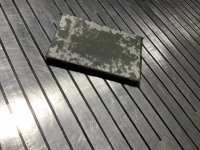
I spray glued some 400 grit to a 1/2” acrylic block with slight rounded edges so as not snag an edge.
To go all this way and ruin a pattern will drive you to drink,,, so go easy
This is important as the thin Kapton could be scratched or even punctured when you tension it horizontally
The stuff is fairly tough in itself but not when it gets a chance to run away from a weak point you create
Cleaning the sandpaper back to original just spray some Lime-a-way on it and in 30 seconds with some water, it will be gone completely.
If I decide to make mid ribbons I believe with a weighted sanding block, one could easily get the .001” foil down significantly before
Before adding the Kapton but thats for another day

Last edited:
Lowmass,
One thing you mentioned was damping and looking at the lower bass section of the Diva, noticed Apogee placed a 10” long thin spacer under the clamping strips to bring the diaphragm (away) from the magnet field for whatever reason and if anyone knows why they did this chime in please.
Thin tight mesh like Quad used might be the best option for some damping in this specific area as I dont want to use their bandaid fix for a slapping panel maybe down there ?
Uncertain
One thing you mentioned was damping and looking at the lower bass section of the Diva, noticed Apogee placed a 10” long thin spacer under the clamping strips to bring the diaphragm (away) from the magnet field for whatever reason and if anyone knows why they did this chime in please.
Thin tight mesh like Quad used might be the best option for some damping in this specific area as I dont want to use their bandaid fix for a slapping panel maybe down there ?
Uncertain
spray 90 is more permanent than 77, However the spray 90 has a spray tip that makes a gloppy thick mess. The 77 has a fine mist spray.
Getting exactly uniform is impossible with these sprays for sure, BUT when u use a very fine spray and get the hang of it, its sonics can compete with stock panel.
BTW IF u are using a kapton or mylar backing thats more than .0005" thick, and or using adhesive thats more than .0005" thick, then there will be some loss in sensitivity AND a slightly "sluggish" quality compared to backing at or below .0005"
Im not sure what your saying here...
"noticed Apogee placed a 10” long thin spacer under the clamping strips "
If your talking about raising the clamping strips up away from magnets so that diaphragm is farther away from magnets , then my suspicion is that this would be done only at the larger end of diaphragm where its tuned to the lowest freq. I would guess they did this to give that section of diaphragm more peak to peak movement without hitting magnets. The section tuned to lowest Fs will need to move more than other sections and they may have raised it for that reason.
As far as "damping" any section of the panel..... you can attach just about anything to back side of magnet array to achieve whatever bass EQ you want. Just make sure its glued down so doesnt rattle or move. U can use various "mesh" anything and vary the mesh open area to tune way u want. More "open"= more deep bass, but at the expense of a somewhat less dynamic quality.
The magnet array/ perforated steel on Apogees leaves only about 10-15% open area. This does a great deal of the "damping" of the diaphragm. It can be altered to taste with nothing more than a few duct tape strips applyed out back. Just about anything will work.
Getting exactly uniform is impossible with these sprays for sure, BUT when u use a very fine spray and get the hang of it, its sonics can compete with stock panel.
BTW IF u are using a kapton or mylar backing thats more than .0005" thick, and or using adhesive thats more than .0005" thick, then there will be some loss in sensitivity AND a slightly "sluggish" quality compared to backing at or below .0005"
Im not sure what your saying here...
"noticed Apogee placed a 10” long thin spacer under the clamping strips "
If your talking about raising the clamping strips up away from magnets so that diaphragm is farther away from magnets , then my suspicion is that this would be done only at the larger end of diaphragm where its tuned to the lowest freq. I would guess they did this to give that section of diaphragm more peak to peak movement without hitting magnets. The section tuned to lowest Fs will need to move more than other sections and they may have raised it for that reason.
As far as "damping" any section of the panel..... you can attach just about anything to back side of magnet array to achieve whatever bass EQ you want. Just make sure its glued down so doesnt rattle or move. U can use various "mesh" anything and vary the mesh open area to tune way u want. More "open"= more deep bass, but at the expense of a somewhat less dynamic quality.
The magnet array/ perforated steel on Apogees leaves only about 10-15% open area. This does a great deal of the "damping" of the diaphragm. It can be altered to taste with nothing more than a few duct tape strips applyed out back. Just about anything will work.
Last edited:
They didnt do it on Stage but not sure about others. Stage bottom section tuned to about 40 hz soo will move much less than lower section of Dive tuned to about 25hz.
Somthing doesnt look right in your measurments.
I have actual roll of original Apogee laminate from many years ago
foil is .0007, silicone is .0003", kapton is .0003" total of .0013"
not sure but this roll may be to make the Stage MRT
Anyway in my own experiments ( hundreds) making bass panels from all combinations of foil/adhesive/backing thicknesses I found that if u stray too far from the above formula you wont get same performance, and too heavy adhesive and backings tend to suck some life out of the sound.
After much experimentation I can say its the balance of foil mass to dead weight mass/ damping thats key here. The Stage base panel is double sided foil so its overall heavyer BUT that extra weight is driven so not a big issue
Somthing doesnt look right in your measurments.
I have actual roll of original Apogee laminate from many years ago
foil is .0007, silicone is .0003", kapton is .0003" total of .0013"
not sure but this roll may be to make the Stage MRT
Anyway in my own experiments ( hundreds) making bass panels from all combinations of foil/adhesive/backing thicknesses I found that if u stray too far from the above formula you wont get same performance, and too heavy adhesive and backings tend to suck some life out of the sound.
After much experimentation I can say its the balance of foil mass to dead weight mass/ damping thats key here. The Stage base panel is double sided foil so its overall heavyer BUT that extra weight is driven so not a big issue
Last edited:
This is from a 1989 diva bass panel and maybe they changed to thinner materials
Later on, but this was what I tried to match and its a little less
And it was hard to find thinner films at a good price. Im sure a little more searching
Might reveal something
I understand the mid/tweeter used thinner materials understandably
The 2 rolls of 1100 aluminum were .001” and measured that way.
The kapton with silicone adhesive were specd at .001” and this didn,t account for the adhesive
Trying to find a suitable Kapton is not an easy affair unless you spend big bucks for a huge roll.
That is the issue... trying to keep the price down with in reason.
Later on, but this was what I tried to match and its a little less
And it was hard to find thinner films at a good price. Im sure a little more searching
Might reveal something
I understand the mid/tweeter used thinner materials understandably
The 2 rolls of 1100 aluminum were .001” and measured that way.
The kapton with silicone adhesive were specd at .001” and this didn,t account for the adhesive
Trying to find a suitable Kapton is not an easy affair unless you spend big bucks for a huge roll.
That is the issue... trying to keep the price down with in reason.
yes it is the big issue. All the readily available stuff is generally 1 mill or thicker. Getting a roll coater to do what u want will be a 20 K $ min order.
IDK, maybe Diva panel thicker BUT my gut says different.
The Stage bass panel used Kapton and adhesives well below 1 mill and the foil was around .0007 to .001"
Also, and I was suprised by this, you would think that everyone would use MUCH thinner on the MRT. I found in my own work this wasnt nessasary, AND later find that Apogee and Magneplaner use .0007-.001 " foil on some of their MRTs.
Its hard for me to see the Diva panel being as thick as your measuring there. Even Maggie uses approx the same thicknesses I mention and I land at those dimensions through trial and error of many listening/ measuring sessions.
Sometimes it can be quite difficult to measure these laminates once they have been corrugated or kinked in any way. When I measured the Stage bass I actually de laminated a small section and removed the silicone , then measured the foil and backing
IDK, maybe Diva panel thicker BUT my gut says different.
The Stage bass panel used Kapton and adhesives well below 1 mill and the foil was around .0007 to .001"
Also, and I was suprised by this, you would think that everyone would use MUCH thinner on the MRT. I found in my own work this wasnt nessasary, AND later find that Apogee and Magneplaner use .0007-.001 " foil on some of their MRTs.
Its hard for me to see the Diva panel being as thick as your measuring there. Even Maggie uses approx the same thicknesses I mention and I land at those dimensions through trial and error of many listening/ measuring sessions.
Sometimes it can be quite difficult to measure these laminates once they have been corrugated or kinked in any way. When I measured the Stage bass I actually de laminated a small section and removed the silicone , then measured the foil and backing
Last edited:
You made me want to double check to see if this digital is off as I purchased it at a swap meet
Not long ago. I did put new batteries in it and always zero the scale
I checked with another Mitutoyo MM direct read mic and came up
With
.085 mm and that equals .00346” so still ballpark measurement
Thats on a clean and flat area Apogee bass panel total thickness
With my veiner calipers ( not as accurate ) it was still over .003”
So I’m confident on this panel at least, of the measurements
Regards
David
Not long ago. I did put new batteries in it and always zero the scale
I checked with another Mitutoyo MM direct read mic and came up
With
.085 mm and that equals .00346” so still ballpark measurement
Thats on a clean and flat area Apogee bass panel total thickness
With my veiner calipers ( not as accurate ) it was still over .003”
So I’m confident on this panel at least, of the measurements
Regards
David
Last edited:
hmmm well I cannot say for sure as I have never laid hands on the Diva.
The problem is I spent years prototyping all kinds of bass panels. Eventually concluding that .0007-.001" foil and much less in backing and adhesive, were close to optimum. This gave the best sensitivity and overall perf in bass panels.
Years latter dissecting Maggies and Apogee stage I find very close to the same as I landed on by trial and error.
Now heres another piece of info. When I do the math looking at Al foil resistivity and the size and length of the traces on the Apogees I calculate they are using somewhere between .0007 and .001 " foil
BTW foil thicker than .001" tends to be quite hard to corrugate. To get an idea , it takes roughly 8 times the force to bend .002" as it does to bend .001" thick foil. Imagine that force over long thin rods of gear stock. Lots of bending.
The problem is I spent years prototyping all kinds of bass panels. Eventually concluding that .0007-.001" foil and much less in backing and adhesive, were close to optimum. This gave the best sensitivity and overall perf in bass panels.
Years latter dissecting Maggies and Apogee stage I find very close to the same as I landed on by trial and error.
Now heres another piece of info. When I do the math looking at Al foil resistivity and the size and length of the traces on the Apogees I calculate they are using somewhere between .0007 and .001 " foil
BTW foil thicker than .001" tends to be quite hard to corrugate. To get an idea , it takes roughly 8 times the force to bend .002" as it does to bend .001" thick foil. Imagine that force over long thin rods of gear stock. Lots of bending.
Regarding the 3m77 and 3m90, I found the 3m90 useless as it sprays from the can, thinned contact cement is better 🙂
actually looking back at my notes on this I see it looks like Apogee may be using .0015" thick foil. So to get .003" + as in your measurments means quite thick backing/adhesive. This may be ok in the bass diaphragms but not good on MRTs. too much dead weight for a tweeter
I use a hard tempered Al foil and have used the 1000 and 2000 series aluminms cant remember wich exact numbers. No change in fatigue resistance between them as far as I could tell and I did a lot of destructive testing. Once u laminate the foil to the backing the composit is far more resilient than straight foil only. Hard temper has a higher yeald point than dead soft so it takes some more force to bend BUT it holds its shape better in actual use.
Yes corrugation should not be that hard for foils under about .0015"
I use a hard tempered Al foil and have used the 1000 and 2000 series aluminms cant remember wich exact numbers. No change in fatigue resistance between them as far as I could tell and I did a lot of destructive testing. Once u laminate the foil to the backing the composit is far more resilient than straight foil only. Hard temper has a higher yeald point than dead soft so it takes some more force to bend BUT it holds its shape better in actual use.
Yes corrugation should not be that hard for foils under about .0015"
Regarding the 3m77 and 3m90, I found the 3m90 useless as it sprays from the can, thinned contact cement is better 🙂
Totally agree, wayyy better. I have some protos laying around that are 15 years old that used good old contact cement. It lasts a very long time AND it damps well.
Last edited:
- Home
- Loudspeakers
- Planars & Exotics
- Anyone making Apogee bass panels?

